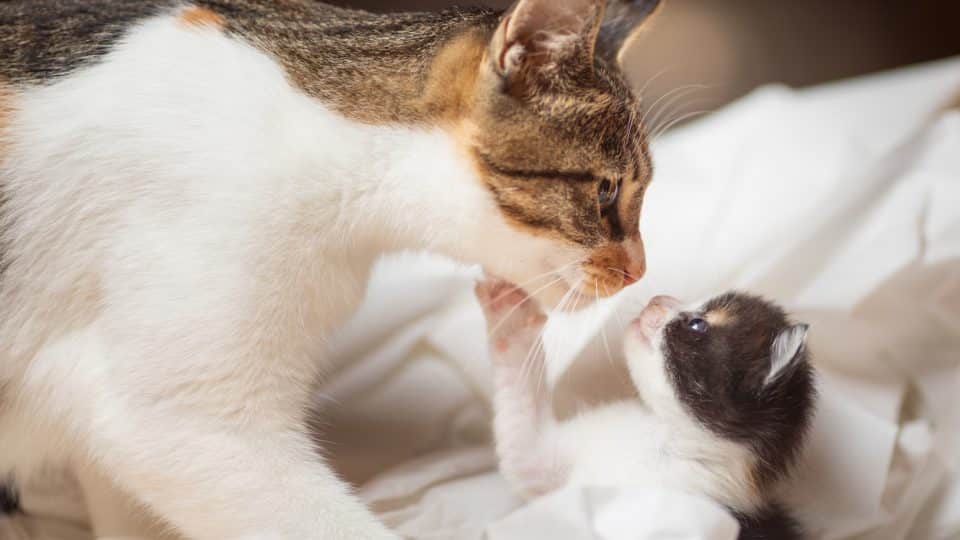- This article has been reviewed by a pet health professional. It is not a substitute for professional veterinary advice.
Are you thinking of getting your cat a buddy to play with? Then you’ll need to know the best way to introduce them. There are steps you can take to help ensure your cats get off on the right paw.
The process is a slow one, but it’s worth it, since good introduction can help your feline friends avoid fights, bullying, territorial spraying, and furniture destruction. It’s a lot harder to repair a relationship between cats than it is to help them start it well.
We spoke with “Cat Daddy” Jackson Galaxy, renowned cat behaviorist, author and TV host, and got his advice for a successful introduction.
Timeline for Cat Introductions
All cats are different, so there’s no definitive timeline for introductions, but patience is key. It will likely take at least a few weeks to complete the introduction process, and it could take between six and 12 months for the cats to develop a friendship. Some cats will be spooning in no time, while others will peacefully co-exist but won’t be pals.
Kittens may have an easier transition with an adult cat because the adult isn’t threatened by the tiny furball and may even take on a parental role. In addition, a kitten hasn’t yet developed the concept of territory.
The opposite may be true when your resident cat is a senior who is set in their ways and may have some health concerns. It could take longer for the elder cat to accept his junior roomie.
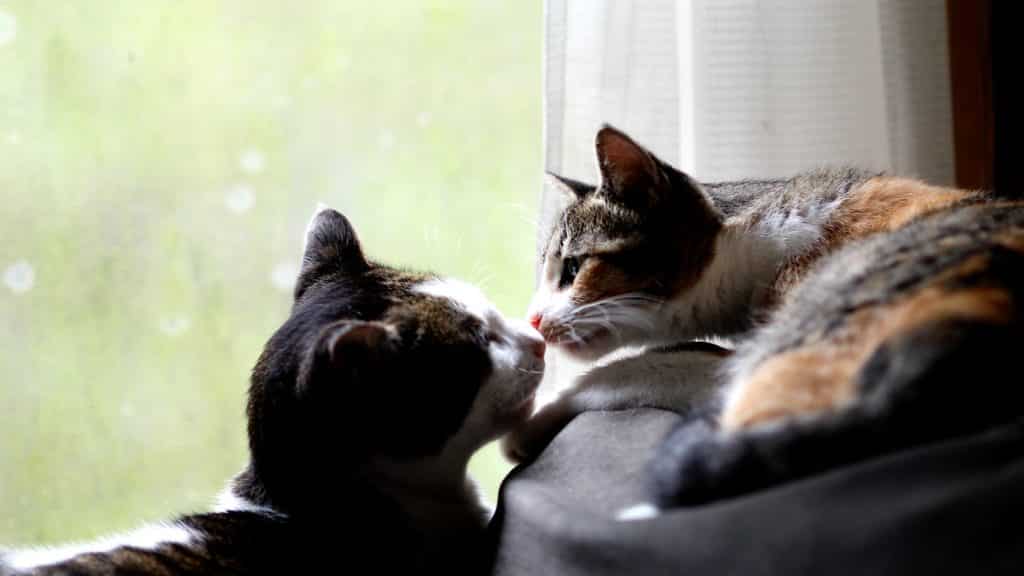
iStock/petesphotography
Step-By-Step Instructions
Galaxy recommends a slow, systematic approach to introductions. “If the cats meet for the first time and that meeting results in a fight, then you’ve got to undo that dynamic, you’ve got to go back and reintroduce them, and then try to do it the right way,” he explains.
Here’s how to get it right the first time.
1. Preparation: stop free feeding
Before your new cat arrives, stop any free feeding and establish a regular feeding schedule for your existing cat. Carefully separated joint mealtimes will help bond your cats down the road—so set a consistent schedule now to help your cat adjust.
2. Separation: create an isolated “base camp”
Next, set up what Galaxy calls the “base camp” for the newcomer. This should be a separate area just for your new cat.
A bedroom or den works well. Galaxy advises against using the bathroom or garage for the base camp if at all possible because these areas don’t have much of the family’s scent on them. Also, the acoustics of the bathroom may be disturbing to sensitive feline ears.
Your newcomer will need a litter box, bed, food and water, plus some toys and scratchers of their own in their cozy space.
Don’t let your existing cat see you bring the new cat into the home. The two cats should be able to smell and hear—but not see or touch—each other.
3. Scent: Give the base camp time to absorb your new cat’s smell
When the new cat first comes home, your resident cat will certainly know something is up. It might be tempting to let them meet face to face, but it’s important to wait for the base camp to start absorbing your new cat’s scent. That will give your new cat confidence.
“The way cats, in the most confident way, learn territory is having just enough of it to mark it with scent, to lie on things, to learn the smells of the house and the neighborhood and all that from a safe space,” says Galaxy.
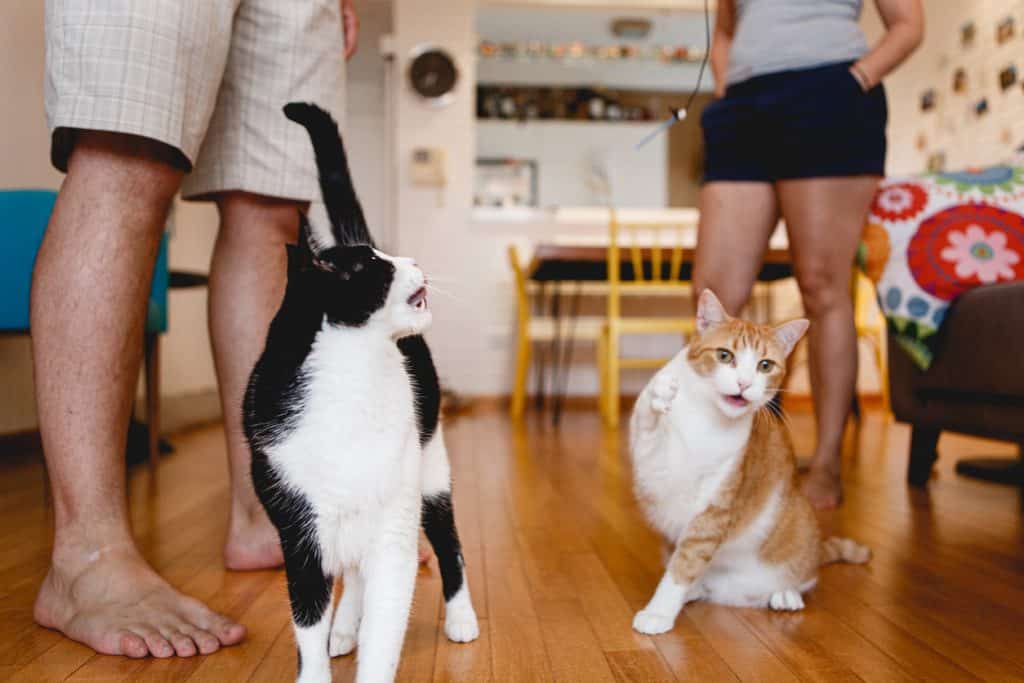
iStock/Capuski
4. Site swapping: let the cats explore each other’s territory separately
Once the cats are comfortable knowing about each other, it’s time for site swapping. Much of cat communication is based on scent, and site swapping is a good way for the cats to exchange scents.
Carry the newcomer out of the base camp, put them in the bathroom, and shut the door. Allow the resident cat to walk into the base camp, then shut that door. Next, allow the newcomer to explore the rest of the home.
Galaxy says it might take the new cat a little time to build up the confidence to explore—anywhere from a few hours to a few days. You can repeat this process once a day or more until both cats are exploring comfortably.
5. Feeding: offer food to each cat separated by a door
To build positive associations with each cat, at mealtimes, set up food bowls ten or so feet apart on opposite sides of the closed door of the base camp. The cats will walk up, eat, and walk away without any problems—but with the sense that there’s another cat on the other side of the door.
Galaxy explains a cat’s thinking: “Every time I get food, I smell you … you can’t be bad.”
Once you’ve had two or three meals with no response, you can move the bowls a little closer, until the cats are 4 to 5 feet apart, then a foot apart. If hissing or growling occurs, take a step back and continue the process.
6. First sight: let the cats see each other through a barrier
When your cats are comfortable eating every meal about a foot apart, it’s time for them to see each other through a barrier. Open the door to the base camp, but section the room off with a tall baby gate or pet gate.
Move the feeding line back to where it started, but now let the cats see each other while they eat. Repeat the move-bowls-closer-to-the-door process every time a meal occurs without incident.
“We make sure that the resident cat does not feel threatened territorially and that the newcomer feels safe enough to start exploring at the same time,” explains Galaxy.
The final step is feeding with the gate open.
7. Monitored interactions: initiate joint play
Once you’re feeding with the gate open, you can begin monitored interactions.
First, control the space by blocking off areas under beds and furniture and closing doors to other rooms. Make sure you have supplies on hand to break up a cat fight, should it come to it. A flattened cardboard box is a good choice. You can also use an empty soda can with some pennies inside to cause a noise distraction. A last resort is tossing a blanket over one cat and removing them from the room.
Next, bring one cat into the room and keep them engaged with a toy. Have someone bring the other cat in and immediately engage them with play or a treat. The goal is keeping each cat focused on play and not on each other.
Galaxy says the worst thing you can do is put both cats in a shared space without giving them something to do. This can result in the other cat being the “something to do.”
After several minutes of play, bring the cats back to their separate quarters and repeat again the following day. “Always end on a high note, even if that high note is, you know, we looked at each other and we didn’t hiss today. Great. Give them treats and call it a day,” says Galaxy.
Be sure to switch off during this process. If yesterday your new cat was put in the room where your resident cat was playing, make sure that the next day you bring the resident cat into where the newcomer is playing.
8. Merge territories
Once you’ve got the cats in an everyday ritual of play and there are no dust-ups, you can remove the door barrier and let the cats roam freely. Introductions are complete!
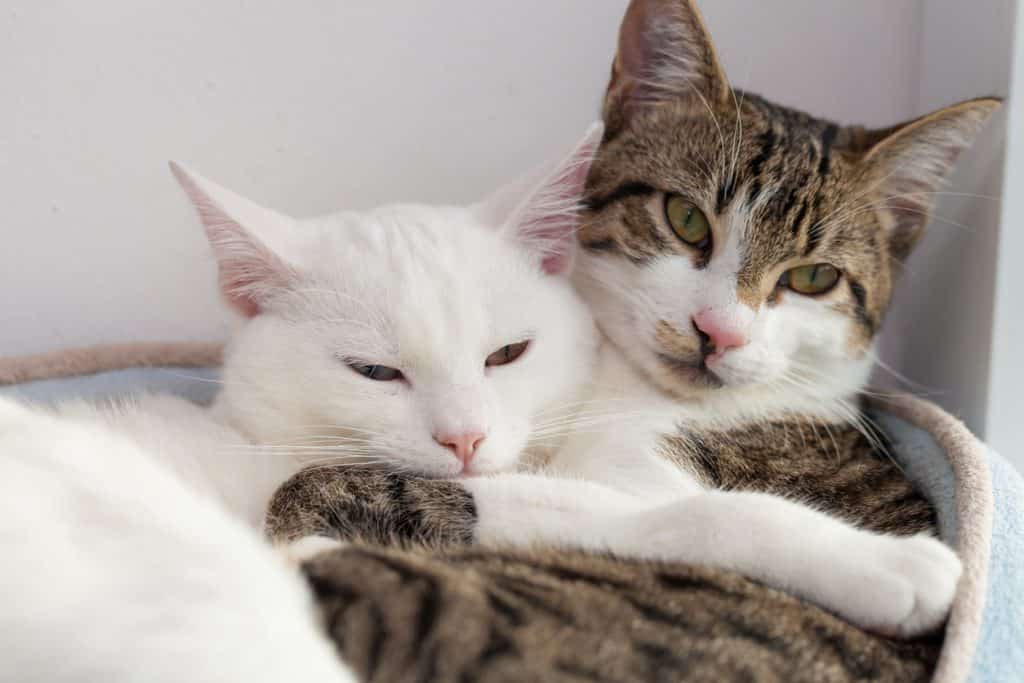
w-ings via iStock
Signs Your Cats Are Getting Along
Signs your cats are comfortable with each other include:
- No hissing or growling. Hissing or growling can be normal when you’re in the introduction process, but if the cats are getting along, this should stop.
- Grooming each other. Mutual licks are the most obvious sign that your cats are doing well.
- Sleeping together. Aside from being adorable, this is another indication the cats are doing great.
- Playing together. Playing means taking turns doing the chasing, and nobody is on the attack.
- Greeting each other. Greeting each other with tails up.
- Touching noses. Touching noses is another sign that your cats are comfortable with each other.
“Touching noses is the handshake,” says Galaxy. “It’s one of the ways that cats create a group identity. It’s a group scent and so we mingle our scents together and it’s a way that we’re sending this message to one another that it’s okay.”
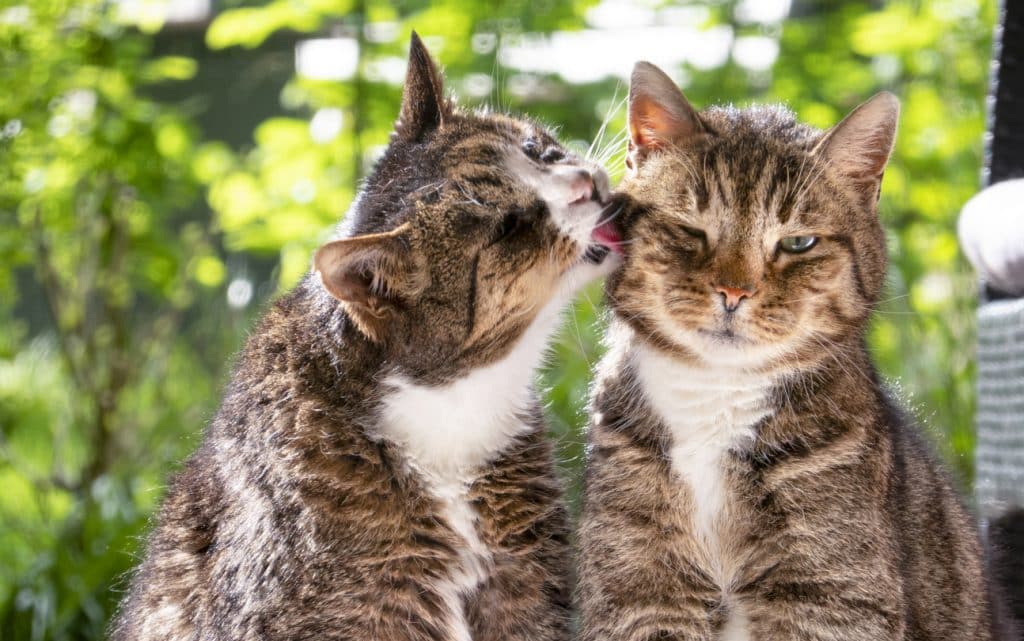
iStock/deepblue4you
Signs You Need To Back Up or Slow Down
After you’ve followed all the steps, your cats should be getting along well, whether that’s cuddling and playing or just co-existing, but keep your eyes open for warning signs of conflict.
Signs of cat aggression include:
- Dilated pupils
- Ears flattened backward on the head
- Hairs standing on end
- Arched back
- Uneven chasing
On the other hand, signs of cat anxiety or fear can be:
- Dilated pupils
- Ears flattened and held outward
- Flattened whiskers
- Wrapping tail around or tucked under body
- Holding head up while lying flat
If you’re noticing any of these behaviors, as well as more extreme anxiety—such as inappropriate urination, destructive scratching or overgrooming—it’s time to take a step back and reassess. You may need to start the process over again.
When To Consult a Professional
If one of the cats is hiding or one of them continuously chases or pursues the other, it’s time to get some help. Your vet can be a valuable resource in developing the best strategies. That may include a short-term plan of medication or calming treats or a consultation with a cat behaviorist who can give you advice for your specific situation.
How Other Pets Factor In
If you have a dog in the home, the first step is assessing your dog’s compatibility with cats. If you haven’t seen how they interact with felines, considering asking a friend or a shelter to help you gauge your dog’s interest before you commit to bringing a kitty home.
“If you know who your dog is, you’ve done the obedience work with your dog, you know they can do this, then we can do the exact same process as we were doing with cat to cat,” says Galaxy.
One important element when introducing a dog and cat is to give the cat the advantage of a high perch, ideally in the in the main social space of the house.
“So the cat can really create a lane of traffic that’s just theirs, and we are short circuiting that feeling that I’m having my territory taken away,” paraphrased Galaxy.
Have Patience
Whether it takes weeks or months, usually your cats will reach a compromise and hopefully start to enjoy each other’s company. Don’t be too dismayed if introduction process is taking longer than you’d hoped.
Says Galaxy, “Know your cat, and know what stress looks like for them, know what anxiety looks like for them, and know that by doing it at their speed, then you’re preventing an anxiety-driven response to a new presence.”
“You have that one chance to make a good first impression, take it,” he advises. “You’ve got nothing to lose, you know, and everything to gain.”
